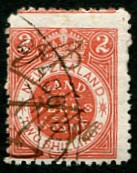These stamps were for the payment of duties, fees and fines in Law Courts or to Registrars of Deeds or District Land Registrars.
Both sets of stamps were authorised by an Act passed in December 1875. Before that, the fiscal stamps first issued in 1867 dealt with everything. The law changed again in 1881 and the use of these special stamps ceased.
The stamps were designed by W.R.Bock and A.E.Cousins and surface printed by the Government Printer in Wellington on paper watermarked NZ and star. Both issues were perforated 12½, nearly 12, and 12 x 11½.
Law Courts
The stamps came into use in January 1876. Initially, they were only used by the Supreme Court and the Court of Appeal while from 1878 they were also used by Magistrates courts.
The plate had 240 impressions in 4 panes of 60.
The issued values were: 1/-, 2/-, 3/-, 5/-, 6/-, 10/-, £1, £3, £5 and £10. There was only one plate with the values being added after the background had been printed.
Land and Deeds
The stamps came into use in July 1877. The following values were produced: 1/-, 2/-, 3/-, 4/-, 5/-, 6/-, 8/-, 10/-, 15/-, 20/-, £3, £5, £10.
The 1/- value was initially issued in a slightly larger size (21 x 25mm)than the others (which were 18 x 22mm) and perf 12½.















We appreciate your engagement with our content. To ensure a respectful and constructive community, please take note of the following:
- No Spam, Please: We do not tolerate spammy or promotional comments. Any such comments will be promptly removed.
- Moderation in Place: All comments are moderated to maintain a positive and inclusive environment. Please be patient, as it may take a little time for your comment to appear.
- Sign In with Google: To comment, please sign in using your Google account. This helps us maintain the integrity of our community and allows for better interaction.